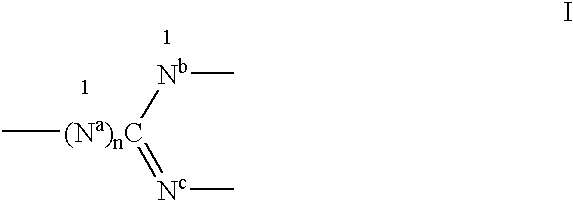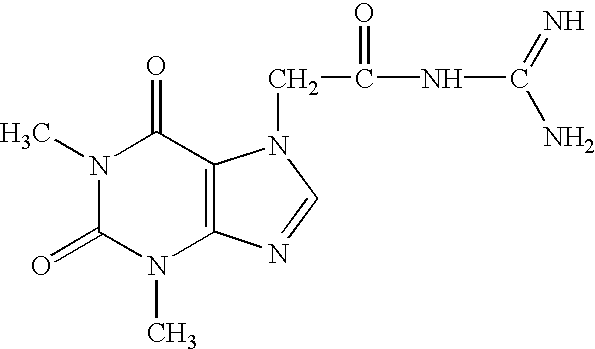Guanidino compounds effective as anesthetics
- Summary
- Abstract
- Description
- Claims
- Application Information
AI Technical Summary
Benefits of technology
Problems solved by technology
Method used
Image
Examples
examples 3-14
Additional Preparations
Following the same procedures as in Examples 1 and 2, additional compounds can be prepared by reacting the reagents to form the compounds as indicated in Table IA, above.
The novel compounds of the present invention have been tested and found to be extremely effective in treating severe neurological disorders of the type resulting from either severe traumatic injury to the spinal cord or from systemic diseases such as multiple sclerosis. These compounds are believed to act upon receptors at several sites. The stimulating of the receptors in the spinal cord, either directly or indirectly, tonically stimulates the motor neurons, thus preserving muscle mass. These drugs generally have long-term ameliorative effects, which apparently bring about a reorganization within the nervous system, providing for regaining of central nervous system control over lost functions in those portions of the body distal to the brain and below the damaged spinal cor...
working example 1
In a further group of six rats the spinal cord was transected in accordance with the above Comparative Examples. After surgery and cleaning and mechanical treatment of the wounds in the same fashion, an intraperitoneal injection of 7-(guanidino-acetyl-theophylline ("C") was administered at a dose of 5.0 mg / kg 24 hours post surgery. Within a 7 to 9 day period, the rats engaged in walking movements of the hind limbs coordinated with those of the front limbs and the hind limbs, including proper plantar placement and full weight bearing on the hind limbs.
Within 36 hours after the spinal cord transection, i.e., only 12 hours after initial administration of Compound C, the initial bloody eyes and nose condition had abated. The muscle mass was not reduced significantly and the animals regained reflex activities much faster than control rats. During the entire course of treatment, the animals did not exhibit any signs of sedation or lethargy. Further the animals were alert and continued to ...
working example 2
It was noted that some of the untreated rats in Comparative Example A developed severe spasticity three weeks after transection. Treatment of three of these control rats with guanphylline (Compound C), intra-peritoneally for 7 days, (4.0 mg / kg BID), resulted in a marked decrease in spasticity within 4 days and a complete elimination after 7 days. None of the rats initially treated with the Compound C developed spasticity at any time.
PUM
| Property | Measurement | Unit |
|---|---|---|
| Concentration | aaaaa | aaaaa |
| Fraction | aaaaa | aaaaa |
| Fraction | aaaaa | aaaaa |
Abstract
Description
Claims
Application Information
 Login to View More
Login to View More - R&D
- Intellectual Property
- Life Sciences
- Materials
- Tech Scout
- Unparalleled Data Quality
- Higher Quality Content
- 60% Fewer Hallucinations
Browse by: Latest US Patents, China's latest patents, Technical Efficacy Thesaurus, Application Domain, Technology Topic, Popular Technical Reports.
© 2025 PatSnap. All rights reserved.Legal|Privacy policy|Modern Slavery Act Transparency Statement|Sitemap|About US| Contact US: help@patsnap.com



